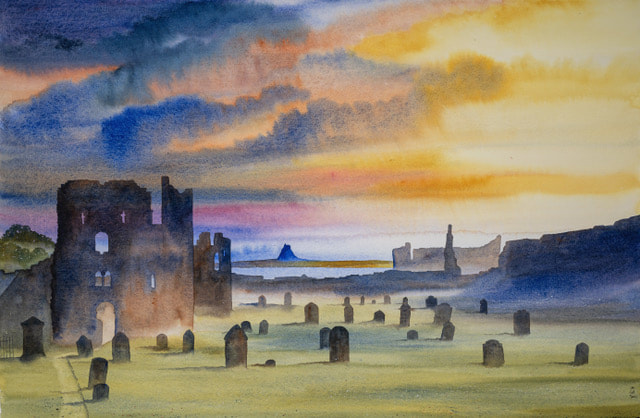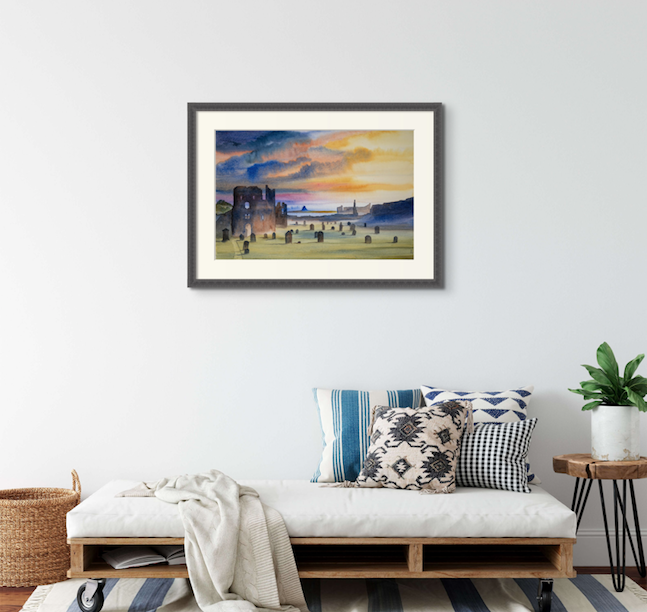Lindisfarne Priory by Ian Scott Massie
Original Watercolour
28" x 36" Mounted size - 22" x 30" Image size
Available: unframed @ £1895
To shop, please click here
28" x 36" Mounted size - 22" x 30" Image size
Available: unframed @ £1895
To shop, please click here
LINDISFARNE
To me, Lindisfarne seems magical. A place of spiritual grace and peace. Lying like a loosely-moored ship off the coast of Northumberland, it was of great importance in the kingdom of Northumbria. Queens, kings, bishops and popes came to ask Cuthbert, Northumbria’s most revered saint, for spiritual and worldly advice.
The island is only accessible when the tide is “open”, as they say on Lindisfarne, and the door closes when the waters flood the sands and the narrow causeway. Much has changed here since the monks made their first church, but much remains the same: the sand dunes, the leaning spikes of marram grass, the curving bay, the wind and the birds, the sea itself, the sun setting behind the hills. It’s seductively easy to put yourself back in Cuthbert’s time, especially when the tide is shut.
In honour of Cuthbert a book was commissioned, in about 715, by the abbot of Lindisfarne. A monk named Eadfrith took up his tools and began work. His fellow brothers brought to him the materials for the great book. Quills and reeds were gathered for pens which Eadfrith carefully cut, making each nib identical in width, so all the lettering would appear even. Oak galls and soot were boiled for ink. Lichen, stone and fruit were transformed into pigments. The greatest task was making the vellum pages, created from 150 calf skins, shaved and stretched and bleached. The book, a set of the gospels, took ten years and, in creating it, Eadfrith seems to have made two inventions. He traced designs on the backs of the fine vellum with lead, which he must have placed in a holder: he’d created a pencil. And in order to see the guide marks, he must have viewed the skins over a light source, so we think he made a light-box.
When finished, the book was bound with a cover made of precious metals and jewels, but somewhere this disappeared, probably plundered in the Viking raids. Miraculously, the book survives. It was made of the materials of the island and created in this extraordinary soul-soaring place and so it speaks of Lindisfarne across the fourteen centuries. Sadly it resides in the British Library, far away. Perhaps one day it will return permanently to the place which created it - the Holy Island.
The island is only accessible when the tide is “open”, as they say on Lindisfarne, and the door closes when the waters flood the sands and the narrow causeway. Much has changed here since the monks made their first church, but much remains the same: the sand dunes, the leaning spikes of marram grass, the curving bay, the wind and the birds, the sea itself, the sun setting behind the hills. It’s seductively easy to put yourself back in Cuthbert’s time, especially when the tide is shut.
In honour of Cuthbert a book was commissioned, in about 715, by the abbot of Lindisfarne. A monk named Eadfrith took up his tools and began work. His fellow brothers brought to him the materials for the great book. Quills and reeds were gathered for pens which Eadfrith carefully cut, making each nib identical in width, so all the lettering would appear even. Oak galls and soot were boiled for ink. Lichen, stone and fruit were transformed into pigments. The greatest task was making the vellum pages, created from 150 calf skins, shaved and stretched and bleached. The book, a set of the gospels, took ten years and, in creating it, Eadfrith seems to have made two inventions. He traced designs on the backs of the fine vellum with lead, which he must have placed in a holder: he’d created a pencil. And in order to see the guide marks, he must have viewed the skins over a light source, so we think he made a light-box.
When finished, the book was bound with a cover made of precious metals and jewels, but somewhere this disappeared, probably plundered in the Viking raids. Miraculously, the book survives. It was made of the materials of the island and created in this extraordinary soul-soaring place and so it speaks of Lindisfarne across the fourteen centuries. Sadly it resides in the British Library, far away. Perhaps one day it will return permanently to the place which created it - the Holy Island.





